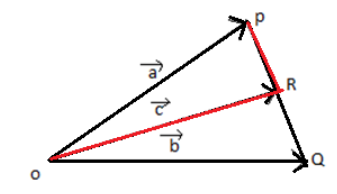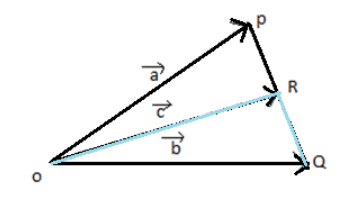
The figure shows the vectors$\overrightarrow a $, $\overrightarrow b $ and$\overrightarrow c $. Where (R) is the midpoint of (PQ). Which of the following relations is correct?

(A) $\overrightarrow a + \overrightarrow b = 2\overrightarrow c $
(B) $\overrightarrow a + \overrightarrow b = \overrightarrow c $
(C) $\overrightarrow a - \overrightarrow b = 2\overrightarrow c $
(D) $\overrightarrow a - \overrightarrow b = \overrightarrow c $
Answer
218.1k+ views
Hint: We first find an equation for vector $\overrightarrow a $ then for vector $\overrightarrow b $ in terms of $\overrightarrow c $ and$\overrightarrow {PQ}$. Using these two equations and finding the sum of them we find the relation between vectors $\overrightarrow a $, $\overrightarrow b $ and$\overrightarrow c $. Since only the relation is asked the formula of the resultant is not necessary
Complete step by step answer:
From the diagram we know that vector $\overrightarrow a $ can be written as sum of vector $\overrightarrow c $ and vector $\overrightarrow {PR} $
$\overrightarrow a = \overrightarrow c + \overrightarrow {PR} $

Vector $\overrightarrow b $ can be written as the sum of vector $\overrightarrow c $ and vector $\overrightarrow {RQ} $
$\overrightarrow b = \overrightarrow c + \overrightarrow {RQ} $

Since the vectors $\overrightarrow {PR} $ and $\overrightarrow {RQ} $ are of equal magnitude and opposite in direction they can be equated as
$\overrightarrow {PR} $=$ - \overrightarrow {RQ} $
Adding vectors$\overrightarrow a $ and $\overrightarrow b $ using the equations formed
$ \overrightarrow a + \overrightarrow b = \overrightarrow c + \overrightarrow {PR} + \overrightarrow c + \overrightarrow {RQ} $
$ \because \overrightarrow {PR} = - \overrightarrow {RQ} $
$\Rightarrow \overrightarrow a + \overrightarrow b = 2\overrightarrow c $
Hence option (A) $\overrightarrow a + \overrightarrow b = 2\overrightarrow c $ is the correct answer.
Additional information: This method is also called the parallelogram method of vector addition. A similar method called the triangle method can also be used to solve the problem. The parallelogram method states that the resultant vector of two different vectors represented in magnitude, direction, by the two adjacent sides of a parallelogram both of which are directed toward or away from their point of intersection is the diagonal of the parallelogram through that point. This diagonal is the resultant vector.
Note: We can also solve this problem by making two equations of vector $\overrightarrow c $ with respect to vector $\overrightarrow a $ and with vector$\overrightarrow b $. Adding these two equations we get $\overrightarrow {2c} $ on the left-hand side and $\overrightarrow a + \overrightarrow b = \overrightarrow {2c} $ on the right-hand side, giving us the same answer.
Complete step by step answer:
From the diagram we know that vector $\overrightarrow a $ can be written as sum of vector $\overrightarrow c $ and vector $\overrightarrow {PR} $
$\overrightarrow a = \overrightarrow c + \overrightarrow {PR} $

Vector $\overrightarrow b $ can be written as the sum of vector $\overrightarrow c $ and vector $\overrightarrow {RQ} $
$\overrightarrow b = \overrightarrow c + \overrightarrow {RQ} $

Since the vectors $\overrightarrow {PR} $ and $\overrightarrow {RQ} $ are of equal magnitude and opposite in direction they can be equated as
$\overrightarrow {PR} $=$ - \overrightarrow {RQ} $
Adding vectors$\overrightarrow a $ and $\overrightarrow b $ using the equations formed
$ \overrightarrow a + \overrightarrow b = \overrightarrow c + \overrightarrow {PR} + \overrightarrow c + \overrightarrow {RQ} $
$ \because \overrightarrow {PR} = - \overrightarrow {RQ} $
$\Rightarrow \overrightarrow a + \overrightarrow b = 2\overrightarrow c $
Hence option (A) $\overrightarrow a + \overrightarrow b = 2\overrightarrow c $ is the correct answer.
Additional information: This method is also called the parallelogram method of vector addition. A similar method called the triangle method can also be used to solve the problem. The parallelogram method states that the resultant vector of two different vectors represented in magnitude, direction, by the two adjacent sides of a parallelogram both of which are directed toward or away from their point of intersection is the diagonal of the parallelogram through that point. This diagonal is the resultant vector.
Note: We can also solve this problem by making two equations of vector $\overrightarrow c $ with respect to vector $\overrightarrow a $ and with vector$\overrightarrow b $. Adding these two equations we get $\overrightarrow {2c} $ on the left-hand side and $\overrightarrow a + \overrightarrow b = \overrightarrow {2c} $ on the right-hand side, giving us the same answer.
Recently Updated Pages
Arithmetic, Geometric & Harmonic Progressions Explained

Cartesian Form of Vector Explained: Formula, Examples & Uses

Apparent Frequency Explained: Formula, Uses & Examples

Calorimetry: Definition, Principles & Calculations

Centrifugal Force Explained: Definition, Formula & Examples

Charge in a Magnetic Field: Definition, Formula & Examples

Trending doubts
JEE Main 2026: Application Form Open, Exam Dates, Syllabus, Eligibility & Question Papers

Derivation of Equation of Trajectory Explained for Students

Hybridisation in Chemistry – Concept, Types & Applications

Understanding the Angle of Deviation in a Prism

Understanding Collisions: Types and Examples for Students

Understanding Atomic Structure for Beginners

Other Pages
JEE Advanced Marks vs Ranks 2025: Understanding Category-wise Qualifying Marks and Previous Year Cut-offs

Units And Measurements Class 11 Physics Chapter 1 CBSE Notes - 2025-26

NCERT Solutions For Class 11 Physics Chapter 8 Mechanical Properties Of Solids

Motion in a Straight Line Class 11 Physics Chapter 2 CBSE Notes - 2025-26

NCERT Solutions for Class 11 Physics Chapter 7 Gravitation 2025-26

How to Convert a Galvanometer into an Ammeter or Voltmeter




